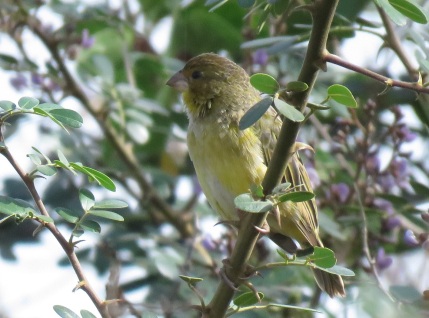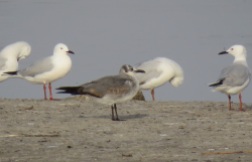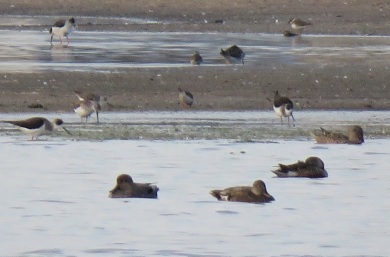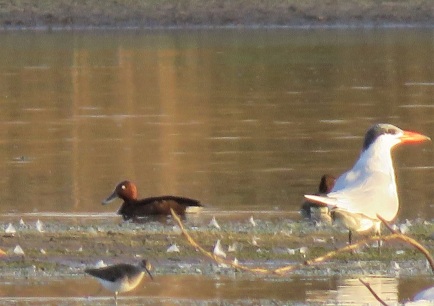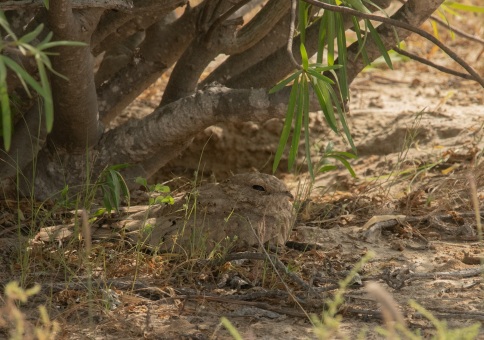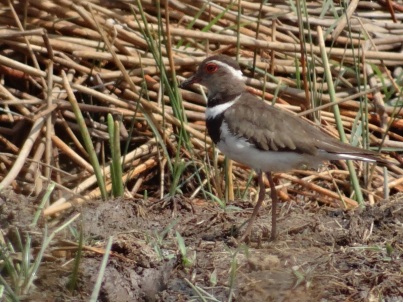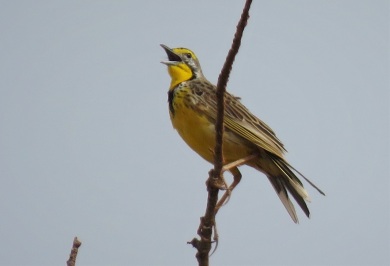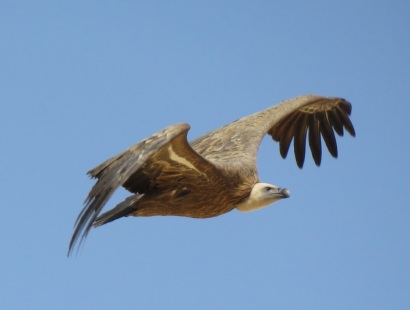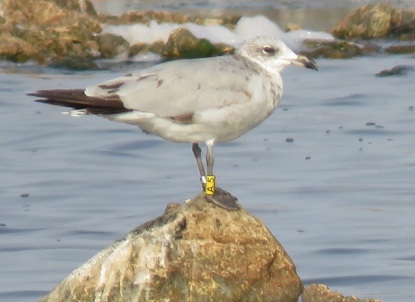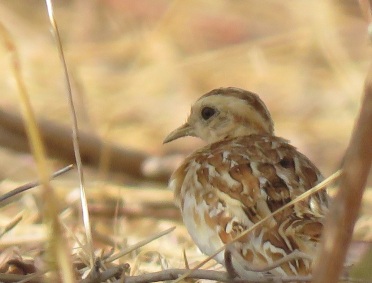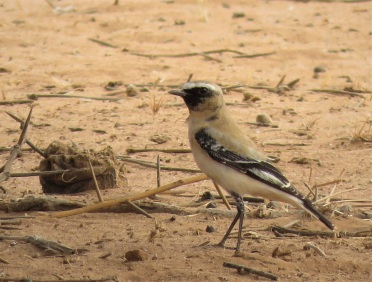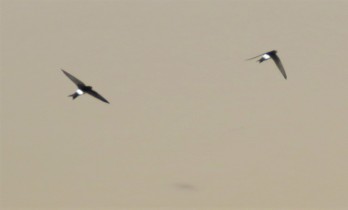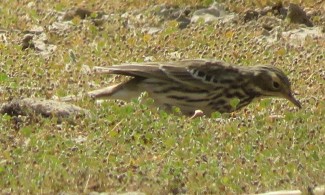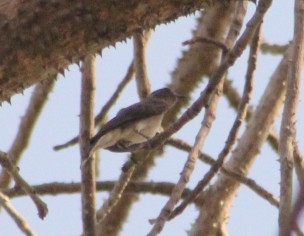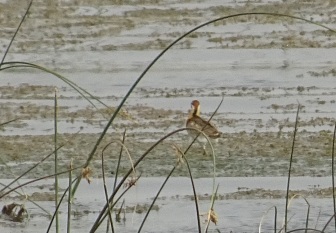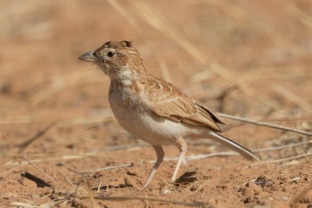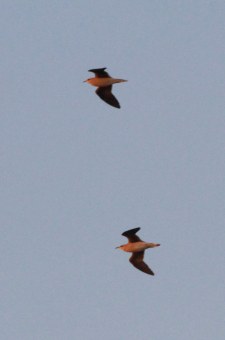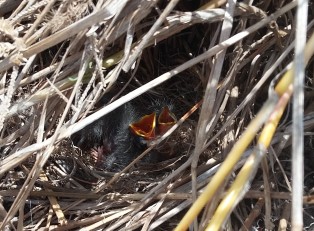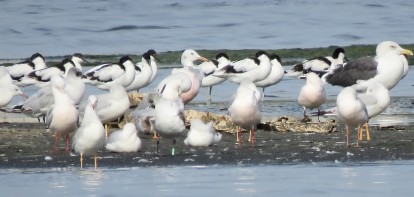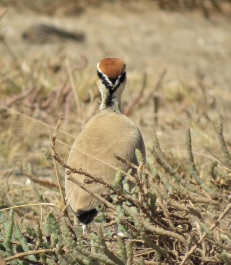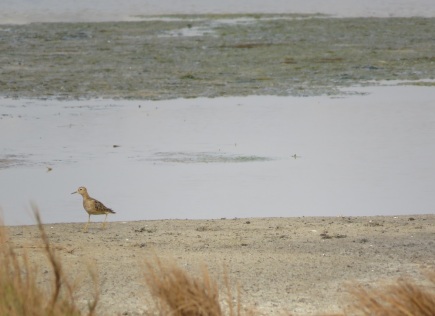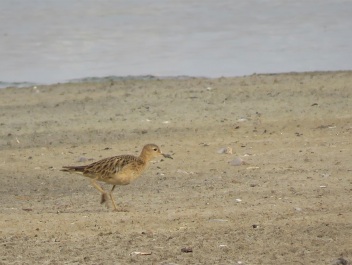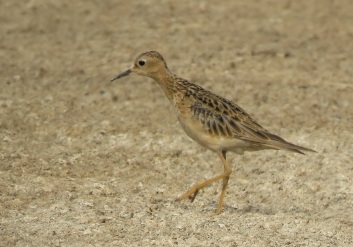Year in review: 2019
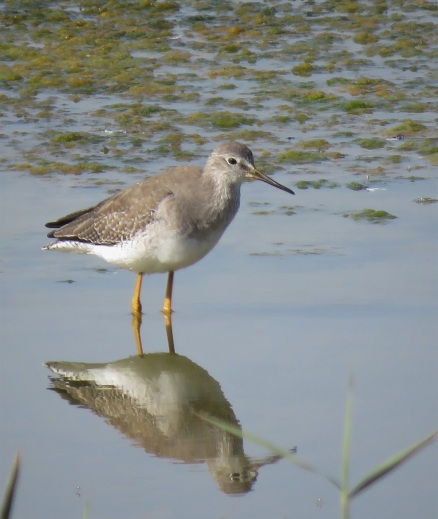
As is now a bit of a tradition on these pages, I’m again compiling a review of last year’s main birding events. Senegal’s bird year 2019 was a pretty good one, with the usual decent mix of new discoveries, rare vagrants, scarce migrants, range extensions and new breeding records.
First things first: last year saw the addition of two new species to the country’s avifauna, so rather similar to previous years – on average, there have been two additions per year during 2014-2018. First a Willcock’s Honeyguide in Dindefelo nature reserve found by Nik Borrow and his group in January, then the discovery of a small group of Cuckoo Finches at Kagnout in Casamance, in February by Bruno Bargain, Gabriel Caucal and Adrien de Montaudouin. As predicted back in 2018, both Dindefelo and Casamance are obviously key areas for finding new birds in the country. Both species are known to occur in neighbouring countries so these additions are not too much of a surprise, and will likely show up again in Senegal in coming years. These “firsts” bring the total number of species confirmed to occur in Senegal to 674, with seven additional species listed as requiring confirmation. The full checklist as per IOC taxonomy (v.8.1) may be found here.
Next up, the usual lot of vagrants: from North America, the now annual American Golden Plovers (Palmarin in April, and Yene in December), the country’s fourth Pectoral Sandpiper at Lac Mbeubeusse on 5.10, and a Lesser Yellowlegs wintering at Technopole – apparently the longest stay recorded in Africa (at least 71 days!), and most likely the same bird seen several years in a row now. Two Laughing Gulls that were present at Technopole in April-May – an adult in breeding plumage and a first-summer bird – were the 6th and 7th records; the immature was also seen at Ngor on 22.5. Also at Technopole were at least two different Franklin’s Gulls, one in January and two in April-May including an adult displaying to other gulls. A Lesser Jacana was found by Vieux Ngom on 16.3 on the Lampsar, while a Spotted Creeper on 17.12 at Kamobeul (Ziguinchor) was another rarely recorded Afro-tropical vagrant. And finally from Europe, a Little Gull – possibly not a true vagrant but rather a very scarce winter visitor – was seen on 8.3 at Ngor, and a European Golden Plover was at Saloulou island (Casamance) on 25.2.
Scarce migrants included a few species of ducks that are rarely reported from Senegal, starting with these three Gadwalls found by Simon Cavaillès at Technopole in January, which were probably the same birds as those seen in December 2018 in The Gambia. A Eurasian Wigeon was present at the same time; while the latter is regular in the Djoudj, both ducks were apparently seen for the first time in the Dakar region.
Almost a year later this pair of Ferruginous Ducks on a small dam at Pointe Sarène near Mbour on 24.12 were a real surprise in this location. Apparently they didn’t stick around: earlier today (19.1.20) I had the chance to visit the dam again but no sign of our two Palearctic ducks…
An African Crake found by Miguel Lecoq in a dry river bed at Popenguine NR on 12.7 was highly unusual. The two Short-eared Owls at Technopole in January (with one still here on 11.2) were possibly returning birds from the 2017-18 influx as they roosted in exactly the same location; another bird was found in the Djoudj on 26.12 by Vieux and Frank Rheindt. Perhaps more unexpected was a Marsh Owl that was actively migrating at Ngor on 8.10, coming from the north out at sea, but even more spectacular was the discovery of an Egyptian Nightjar by Frédéric Bacuez on his local patch at Trois-Marigots, on 23.10 (an early date and first in this location); in the Djoudj NP, a somewhat classic location for the species, three birds were seen several times from 23.11 up to mid December at least.
A few Red-footed Boobies were again seen at Ngor: an adult on 3.7 and likely the same bird again on 22.7, then daily from 9-12.8 (with two here on 17.8), and again an imm. seen twice in November. These are the 5th to 7th records, a remarkable presence given that the first record was in October 2016 only! As usual, several Brown Boobies were seen as well but we didn’t get the chance to properly check on the birds at Iles de la Madeleine this past year. Other scarce seabirds seen from Ngor were a Balearic Shearwater (18.11), a Bulwer’s Petrel (5.12), several Leach’s Storm-Petrels (11 & 13.11), and some 30 Barolo’s/Boyd’s Shearwaters that passed through in August and September. A Baltic Gull (fuscus Lesser Black-backed Gull) at Technopole 27.1 was our first record here.
Quite a few birds were reported for the first time from Casamance by Bruno and friends, and several resident forest species that had not been seen in many years were “rediscovered” this past year, such as Black-shouldered Nightjar, Black Sparrowhawk, White-throated and Slender-billed Greenbuls, Flappet Lark, Red-faced and Dorst’s Cisticolas – the online Casamance atlast can be found here. Several Senegal Lapwings were again seen towards the end of the rains, and a Forbes’s Plover at Kagnout on 17.2 was definitely a good record as the species had previously been reported only on a few occasions from the Niokolo-Koba NP.
A Brown-throated (= Plain) Martin feeding over the lagoon at Technopole on 28.4 was a first for Dakar; this species is rarely seen in Senegal it seems. A few Moltoni’s Warblers were reported in autumn including at least one on 20.10 at Mboro, where Miguel also noted several northward range extensions such as Fine-spotted Woodpecker, Grey Kestrel, Splendid Sunbird, and Orange-cheeked Waxbill. The observation of two Mottled Spinetails some 15km south of Potou (Louga region) is the northernmost so far and seems to confirm the presence in this part of the country, following one in the same region in January 2018. A pair of Little Grey Woodpeckers at Lompoul and the discovery of Cricket Warbler in the Gossas area (Diourbel) are also noteworthy as they are just outside known distribution ranges for these two Sahelian species. More significant is the observation of a Long-billed Pipit on the Dande plateau near Dindefelo on 9.2, as this is the first record away from the Djoudj area, raising the possibility that the species is breeding in the vicinity.
Additional good records for the Dakar region included a White-throated Bee-eater on 12.8, a Red-breasted Swallow near Diamniadio on 11.10 and Grasshopper Warblers at Yene lagoon on 8 & 15.12, as well as at Lac Tanma (Thiès region) on 27.10 – and more surprisingly, one was found aboard a sail boat some “400 Miles South West Of Dakar” on 13.9. Last year we documented oversummering of Yellow-legged and Mediterranean Gulls on the peninsula.
We also continued our modest efforts to survey breeding Black-winged Stilts at several sites in Dakar, Ziguinchor and Saint-Louis; the findings of these should be formally published later this year. The Horus Swift colony was visited on several occasions (Jan.-March and Nov.-Dec.) with further evidence of breeding. A pair of Tawny Eagles at their nest site on a high tension pylon near Ndioum, where they are known since at least 2015, were seen again in December by Frédéric and Jérémy. Yellow-throated Longclaw was found to be breeding at lac Mbeubeusse and probably at lac Rose as well: more on the species in this post.
In July we found several additional pairs of Turati’s Boubou right on the border with Guinea-Bissau, a bit further to the south of the site where Bruno initially found the species, in October 2018 near Ziguinchor. Also in Casamance, breeding was confirmed for Common Buttonquail, Golden-tailed Woodpecker, and a whole range of other species.
Another noteworthy record is that of a group of 113 Eurasian Griffons in the Djoudj NP on 2.11 – apparently the largest flock ever recorded in Senegal! This surely reflects the general increase in numbers of what used to be a rather scarce species it seems – read up more on the status of this vulture in Senegal in this post on Ornithondar.
As usual, a few interesting ring recoveries were obtained, including several returning birds, providing further evidence for site fidelity and local movements between key sites for e.g. Black-tailed Godwits and Ospreys of course, but also for a Eurasian Spoonbill from Spain – more on this in a future post. A Gull-billed Tern from the Neufelderkoog colony in northern Germany was also a good recovery, just like the many Sandwich Terns that we managed to read at Technopole in April-May with birds originating from Ireland, the UK, the Netherlands and Italy! Also of note were a French Black-headed Gull, the first colour-ringed Greenshank and wing-tagged Marsh Harrier in our ever-growing database, and last but not least the first recovery of a Croatian-ringed bird in Senegal, an Audouin’s Gull seen at three sites in Dakar in January and February.
During 2019 I was fortunate to continue our regular coverage of Technopole but also for the third consecutive year of seabird migration at Ngor, and managed a few trips further afield: the northern Saloum delta (Simal, Palmarin), three trips to Casamance (January, May, July), the Petite Côte (at long last explored the lagoons at Mbodiene!), the Langue de Barbarie and Trois-Marigots in April, the Djoudj and other parts of the lower Senegal valley (November), and finally Toubacouta in December. Oh and a memorable day trip on a successful quest for the enigmatic Quail-Plover!
Other blog posts this past year covered the status and distribution (and a bit of identification!) of Seebohm’s Wheatear, Iberian Chiffchaff, and Western Square-tailed Drongo.
Another series focused on recent ornithological publications relevant for Senegal, in three parts. I’m not sure how I managed but in the end I was involved in quite a few articles published in 2019: the autumn migration of seabirds at Ngor and the status of Iberian Chiffchaff in West Africa (the latter with Paul Isenmann and Stuart Sharp) in Alauda, the first records of Eurasian Collared Dove and of Turati’s Boubou in Senegal (the latter with Bruno Bargain) published in Malimbus, and finally two papers in the Bulletin of the African Bird Club: a short piece on the hybrid shrike from lac Tanma in 2017 (with Gabriel Caucanas), and a review of the status of the Short-eared Owl in West Africa, following the influx during winter 2017/18.
Many thanks to all visiting and (semi-)resident birders who shared their observations through eBird or other channels, particularly Miguel, Frédéric and Bruno. The above review is of course incomplete and probably a bit biased towards the Dakar region: any additions are more than welcome and will be incorporated!
Technopole – more gulls, breeding waders & more

It’s been a while since Technopole last featured here, mostly for a lack of birds… With water levels now extremely low – the main pond only has a few shallow patches of water left – and as a result bird numbers are very low. Just a few hundred Black-winged Stilts, and Spur-winged Lapwings, 100-200 Slender-billed Gulls, the odd Audouin’s and a few oversummering Black-headed Gulls, a few lone waders here and there, 6-8 Greater Flamingos and that’s about it. Luckily there’s always something to see at Technopole, and even if overall numbers of migrants are low at the moment, there’s always some of the local species for which it’s now breeding season!
But more about the gulls first.
One of the previous winter’s Mediterranean Gulls remained up to 10 June at least but only allowed for a few poor records shots, rather unusually a 2nd summer (rather than 1st summer) bird. Apparently the first June record for Senegal, of what in the past 10-20 years has become a regular winter visitor in small numbers to the Dakar region. The last Yellow-legged Gull (Goéland leucophée) was seen on 2 May, also a rather late date.
Actually I just realised that I hadn’t shared some of the better pictures of the star bird of the spring here: the 2nd c.y. Laughing Gull, which ended up staying from 25 April until 22 May at least. With the exception of the adult bird this spring (which was seen only twice by two lucky Iberian observers 🙂 on 21-23 April), all previous records were one-day-wonders.
And while we’re at it, here’s the stunning adult Franklin’s Gull in breeding plumage, which unfortunately didn’t linger and was seen just once, on 30 April, at fairly long range hence the hazy pictures:
This bird is from the following day, probably the 2nd summer seen several times between 13 April and 2 May:
Several Black-winged Stilts are still on the nest, but breeding success appears to be low (because water levels are too low, making the nests more vulnerable?). Only a handful of little stiltlets are seen on each visit, and hardly any older juvs. are around. Wondering whether those at Lac Rose may be more successful this year…
A welcome surprise though was a tiny Kittlitz’s Plover chick (Gravelot pâtre), barely a few days old, seen on 10 June. Previous breeding records here were in June 2016 (probable) and July 2012.
Greater Painted-Snipe (Rhynchée peinte) may also be breeding as a pair was seen on 23 June and a male two weeks earlier in the same area (past golf club house on edge of lake near the small baobab!).
And this year there are quite a few Little Bitterns around, quite obviously more than in previous years, with sightings including several singing birds and pairs in at least five locations. I guess the number of territories all over the Grande Niaye de Pikine could easily exceed 10-12 pairs/singing males. Here’s a rather poor picture of a pair seen on our most recent visit, just before it flew off:
Little Grebe (Grèbe castagneux) was once again confirmed to be breeding, though later than in previous years: an adult with a still downy juv. (aged 1-2 weeks?) was on the small pond past the golf course on 10 June, in the same site as in previous years. Previous records in central and northern Senegal were during Dec. – April (read up more about the breeding status of Little Grebe in Senegal & Gambia in this paper that we published in Malimbus last year)
Another nice surprise last Sunday (23/6) was the first Diederik Cuckoo (Coucou didric) of the season in these parts of the country: a singing bird flew high over the pond coming from the Pikine side, then was heard again later on in the tree belt near the football field. Almost as good as hearing the first Common Cuckoo in early April, back “home” in Geneva!
We’re almost there! In the end, there’s been quite a lot to catch up on since early May…
This colour-ringed Gull-billed Tern which I think I’ve mentioned before is indeed from the small colony of Neufelderkoog in northern Germany – the only site where the species breeds north of the Mediterranean region – and as it turns out it’s only the second-ever resighting of one of their birds in Africa. The first was that of a first-winter bird seen in February 2017 in Conakry, Guinea. Our bird ended up staying at least 16 days, from 13 – 28 April. It was ringed on 18 July 2017 by Markus Risch (“WRYY”: white-red/yellow-yellow) and was a late or replacement brood, and the bird was among the latest fledglings of all.
This Common Ringed Plover was around for some time in April / early May, ringed in Norway (details yet to be submitted).
Also on the ringing front, we’re still waiting to hear back for some of the 40-50 Sandwich Tern ring readings Miguel and I managed to make this spring. One of the most recent birds, seen on May 1st, was ringed in June 2017 at Hodbarrow RSPB reserve in Cumbria (UK), and was already spotted on 25/11/17 at Kartong in Gambia (4,720 km, 148 days). While 2nd c.y. birds all stay in Africa during their first summer, third calendar-years such as this one may already migrate back to Europe.
Rounding off the overview with the most recent addition to the Technopole list: African Wattled Lapwing (Vanneau du Sénégal), which surprisingly had not been seen so far, at least not as far as I know – seems like the species actively avoids dense urban areas, since they are regular just outside Dakar but obviously a bit of a vagrant here in town. One was seen flying past, calling a few times, on 10 June.
Species number 239!
Let’s see if we can manage to find 240 in the next few weeks.
The Great Re-Tern

April is Tern month!
From mid-March into May, lots of terns pass through Dakar on their way back home from the wintering grounds further south – some as far as South Africa! – and the first half of April is definitely peak time for many species. When conditions are right, literally thousands of these elegant birds may pass through on a single day, and sites such as Technopole can hold several hundreds of birds at any one time. So much that in the past week, I’ve had the chance to see 12 out of the 14 tern species that are known to occur in Senegal, the only ones missing being Bridled and the rare Sooty Tern.
On Monday 8.4 at Technopole, decent numbers of terns were about, mainly Sandwich Tern (+300, likely quite a bit more) with a supporting cast of the usual Caspian and Gull-billed Terns (the former with several recently emancipated juveniles, likely from the Saloum or Casamance colonies), but also several dozen African Royal Tern, a few Common Terns, at least two Lesser Crested, and as a bonus two fine adult Roseate Terns roosting among their cousins. And as I scanned one of the flocks one last time before returning back home, an adult Whiskered Tern in breeding plumage, already spotted the previous day by Miguel. I managed to read four ringed Sandwich Terns but far more were wearing rings, but were impossible to read.
Yesterday 13.4, we went back to our favourite urban hotspot mainly in order to see if we could read some more of these rings. The main roost is close to the northern shore of the main lagoon, quite close to golf club house, which makes it possible to get close enough to the birds to read most rings. We saw most of the same tern species (except Roseate), with the addition of a fine moulting White-winged Tern and a small flock of Little Terns migrating over our heads. The first colour-ringed bird we saw was actually a Gull-billed Tern, but not the usual Spanish bird (“U83”) ringed in 2009 and seen several times herein the past three winters. This bird was even more interesting, as it was ringed in the only remaining colony in northern Europe, more precisely in the German Wadden Sea. Awaiting details from the ringers, but it’s quite likely that there are very few (if any!) recoveries of these northern birds this far south. It may well be the same bird as one that we saw back in November 2018 at lac Mbeubeusse, though we didn’t manage to properly establish the ring combination at the time.
So, back to our ring readings: all in all, we managed to decipher an impressive 14 Sandwich Tern rings – blue, white, yellow & red! – of birds originating from no less than four countries: Ireland, UK, Netherlands, and one from Italy (to be confirmed). Most of these are chicks that were born in summer 2016 and that logically spent their first two years in the Southern Hemisphere, and are now returning back to their breeding grounds for the first time. In addition, a Black-headed Gull with a blue ring proved to be a French bird ringed as a chick in a colony in the Forez region (west of Lyon) in 2018, while a Spanish Audouin’s Gull was a bird not previously read here. I’ll try to find some time to write up more on our ring recoveries, now that my little database has just over 500 entries!
Others local highlights from these past few days are the Lesser Yellowlegs still at Technopole on 8.4 (but not seen yesterday… maybe it has finally moved on), also a superb breeding plumaged Bar-tailed Godwit, still a few Avocets, plenty of Ruff, Little Stint, Sanderling, Curlew Sandpiper and Dunlin, many of which in full breeding attire. And on 13.4, once again a Franklin’s Gull, but also a rather late Mediterranean Gull and what was probably the regular adult Yellow-legged Gull seen several times since December. Three Spotted Redshanks were also noteworthy as this is not a regular species at Technopole. The Black-winged Stilts are breeding again, and the first two chicks – just a couple of days old – were seen yesterday, with at least two more birds on nests; a family of Moorhen was also a good breeding record.
Full eBird checklist from 13.4 here.
Earlier this week at the Calao was just about as good in terms of tern diversity: again the usual Sandwich Terns which are passing through en masse at the moment, with some LCT’s in the mix, several dozen Common Terns and the odd Roseate Tern hurriedly yet graciously flying past the seawatch spot, and of course more Royal Terns en route to Langue de Barbarie or Mauritanian breeding sites, a lone Caspian Tern, and this time round an even less expected White-winged Tern (and just two Black Terns). Oh and also the first Arctic Tern of the season! The first birds in spring are typically seen at the end of March or first half of April; earliest dates (2015-2018) are 16.3.18 and 25.3.16. The numbers of migrating terns were really impressive here on Saturday 6.4: a rough estimate puts the number of Sandwich and Common Terns passing through at 500 and 1200, respectively, in just two hours.
At Ngor, regular morning sessions have yielded the usual Pomarine and Arctic Skuas, Northern Gannets, as well as a handful of Cape Verde Shearwaters feeding offshore on most days. Sooty Shearwaters passed through in good numbers on 6.4, while last Friday (12.4) was best for Sabine’s Gull: 73 birds in just one hour, so far my best spring count. Also several Long-tailed Skuas and the other day a South Polar or (more likely) a Great Skua was present, a rare spring sighting. All checklists for the recent Calao counts can be found on this eBird page.
Year in review: 2018
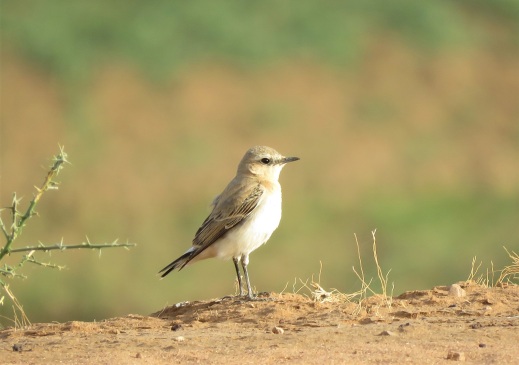
Just like last year we’re bringing our readers a summary of the past year, reviewing some of the ornithological highlights and discoveries made in Senegal, and recycling some of the pictures and posts that appeared on this website during the past 12 months.
2018 certainly has been a busy year!
We’ll start with the best of all: the discovery of what appears to be an isolated (?) population of Horus Swifts (Martinet horus), some 3,000 km from the nearest known breeding sites and more than 1,600 km from the nearest observations of the species (in northern Ghana). This is probably one of the least expected range extensions uncovered in West Africa in recent years, and something we’re of course quite excited (and rather proud!) of. We found these birds during an epic 4-day trip up north together with Frédéric Bacuez and visiting birder Filip Verroens from Belgium, in early January. Needless to say, the year started off with a bang! Read up the full story here and on Frédéric’s Ornithondar blog (in French). A few of these neat swifts were seen again in February by Frédéric and Daniel Nussbaumer, then in October by Vieux Ngom and myself when some 50 birds were present, again showing signs of local breeding and confirming that these birds are most likely residents here, and just last week a group of visiting American birders saw about 25 birds at Gamadji Sare.
Just a few days earlier, in fact on the first day of the year, we’d already found another species new to Senegal: a Meadow Pipit (Pipit farlouse) at the Yene-Tode lagoon just south of Dakar. This find was a bit more controversial – but probably more expected than those swifts! – in the sense that the pipit shows a fairly unusual plumage for Meadow Pipit and certain characters fit Red-throated Pipit better. However, the unstreaked rump and especially the diagnostic call, which was heard loud & clear several times at close range (but unfortunately not sound-recorded), safely rule out Red-throated Pipit, several of which were present in the area at the same time. Full story, description and many pictures here.
Continuing on the same theme, this past year saw the addition of two more species to the Senegal list: Brown-backed Honeybird – which had already been reported from Wassadou in 2015 but was not documented – and Turati’s Boubou. The former was found by Gabriel Caucanas and friends first at Dindefelo, then at Wassadou and later in the Niokolo-Koba NP (more info here), the latter by resident Casamance birder Bruno Bargain back in October. Both were more or less to be expected and back in July we’d actually predicted that the boubou would be found in Casamance some time soon, given that it is known to occur just across the border in Guinea-Bissau. We’ll write up more about this species in due course, and I hope to soon visit the Ziguinchor area again and see (and record) this little-known species – stay tuned!
With no less than four new species, 2018 definitely boosted the national list which now stands at a respectable 678 species; more on this in a blog piece we wrote on the topic of the national list, which contains a link to a handy spreadsheet with all species seen in Senegal, with English, French and scientific names.
Of course there were also the usual lot of vagrants, mostly Nearctic waders in the Dakar region and especially at Technopole, pretty much as usual!
- Common Shelduck (Tadorne de Belon): eight in the Djoudj NP on 17/1 were likely the same group as seen in the Diawling just across the border in Mauritania on 30/12, while one at Technopole on 18-19/2/18 confirmed the small influx that occurred during the ‘17/’18 winter: 8th and 9th records!
- Red-footed Booby (Fou à pieds rouges): one was photographed at Iles de la Madeleine on 26/1 but was only identified later on, while at Ngor up to two adults were seen on several occasions in spring (17/5-22/5, and again on 11 and 22/6) and one was seen twice in autumn (13 & 15/11). These are the 2nd to 4th records for this tropical seabird, which was seen for the first time in October 2016 only.
- Cinereous (=Black) Vulture (Vautour moine): an imm. west of Fatick on 30/1 and one (different bird) on 26/2 near Sagata, east of Kebemer. These observations coincide with the first records for The Gambia (Feb. ‘18) and Mauritania (Dec. ‘17). We also reported the first record of the species, which had not yet been published so far – more details on the status of this increasing Palearctic vagrant in this piece.
- American Golden Plover (Pluvier bronzé): one at Technopole on 8 April, followed by two autumn birds, at lac Mbeubeusse on 3/11 and barely a week later a different bird at Pointe Sarene near Nianing on 9-10/11. Read more on this species in Senegal here.
- European Golden Plover (Pluvier doré): one at Île de Saloulou (Basse Casamance) on 3/1.
- Lesser Yellowlegs (Chevalier à pattes jaunes): the 8th record was one at Technopole seen by a visiting birder on 8/2 and relocated on 19/2
- Baird’s Sandpiper (Bécasseau de Baird): the second for Senegal (and first properly documented) was found at Technopole on 25/3 and seen again on 8/4.
- Buff-breasted Sandpiper (Bécasseau rousset): two birds stayed for a remarkably long time at Technopole, being present from 13/1 (at least one) up to 19/2 at least, then again on 25/3 though this was probably a new bird given that regular visits earlier in the month failed to relocate the two long-stayers; these are the 8th and 9th records.
- Red-necked Phalarope: (Phalarope à bec étroit): one at Djoudj on 27/2 is the 6th record at least, though it’s quite possible that the species is a more regular visitor than the handful of confirmed records suggest.
- Franklin’s Gull (Mouette de Franklin): one was seen five times between 20/5 and 20/9 at Technopole; we summarised the status and trends of the species in this post.
As usual there are also several African vagrants to be reported, such as Lesser Jacana (Jacana nain) seen on 31/1 and 17/2 (three birds!) at Médina Afia near Manda, Kolda dept., and at Ross Bethio on 15/7 – there are only a handful of previous records, including just one in the north (more on status of this species in this post by Ornithondar). A Pharaoh (= Desert) Eagle-Owl (Grand-duc ascalaphe) filmed at Richard Toll on 20/1 was the third record. Six Senegal Lapwings were found at Kamobeul (Ziguinchor) on 30/9 – apparently the first record in 38 years! Three other species with uncertain status in Senegal – true vagrants or scarce but regular visitors? – were seen in the Niokolo-Koba area: Mottled Swift in February and June; a Forbes’s Plover in June and an Ayres’s Hawk-Eagle on 6/3 (Martinet marbré, Pluvier de Forbes et Aigle d’Ayres) .
A special mention goes to the Kordofan Lark (Alouette du Kordofan) that was photographed at Richard Toll on 1/3 by a group of lucky Belgian birders; this is the first record in several years, and the first pictures to be made available online for this species, prompting us to discuss ID criteria and status in Senegal of this enigmatic Sahel special, see this blog piece co-authored with Simon Cavaillès – by far the most read article on the blog, with more than 500 views since its publication in April.
Several winter visitors were seen in higher than usual numbers or reached areas further south than their usual wintering grounds, such as Short-eared Owl (Hibou des marais; seen in six locations during January-March including a group wintering at Technopole, following the influx in Nov.-Dec.). Other scarce winter visitors included a Little Gull (Mouette pygmée) at Ngor on 12/1, while a group of five Cream-coloured Coursers (Courvite isabelle) near Maleme Hodar (Kaffrine) on 1/3 were possibly the southernmost record ever. Other examples include a Spectacled Warbler (Fauvette à lunettes) near Kaolack on 3/3, a “Desert” Grey Shrike (now surprisingly lumped again with Great rather than Southern Grey Shrike; Pie-grièche grise) in the Boundou reserve on 15/3, and five House Buntings (Bruant du Sahara) at Richard Toll on 1/3.
As usual, a few birds were spotted outside of their regular range in the country: several Pallid Herons on the Cap-Vert peninsula; an African Hawk-Eagle that gave us a bit of an ID challenge at Popenguine (3/11); a Greyish Eagle-Owl photographed at Trois-Marigots on 10/1 (only a couple of previous records from N Senegal, see story on Ornithondar); a Grey Phalarope on 25/2 at Médina Afia (a rare inland record!); a singing Klaas’s Cuckoo near Dagana on 6/10; a Broad-billed Roller at Bango (Saint-Louis) on 31/8; Grey-rumped Swallow at Technopole (7/7); an early Lesser Whitethroat at lake Tanma on 25/9; a Cricket Warbler near Gueuol (north of Kébémer) on 21/11 (Aigle fascié, Grand-duc du Sahel, Phalarope à bec large, Coucou de Klaas, Rolle violet, Hirondelle à croupion gris, Fauvette babillarde, Prinia à front écailleux). In the Djoudj, a Brown Snake-Eagle was reported on 5/12. Familiar Chat and Green Turaco were reported from the Niokolo-Koba NP for the first time, where further observations of Mali Firefinch were made (Traquet familier, Turaco vert, Amarante du Koulikoro). Several species were found for the first time in Casamance, including Glossy Ibis, Singing Bushlark, Plain Martin, Great Reed Warbler – details will follow shortly on this website (Ibis falcinelle, Alouette chanteuse, Hirondelle paludicole, Rousserolle turdoïde). Away from the better known wintering grounds in the north of the country, an Iberian Chiffchaff (Pouillot ibérique) was singing at Wassadou on 25/2, and the Technopole bird found on 31/12/17 continued its presence until 7/1 at least.
New breeding records include what appears to be the first confirmed breeding for the Dakar region of Little Tern in June at Lac Rose with at least 14 nests; in the same location we found a nest of Plain-backed Pipit, while a Quailfinch at lac Mbeubeusse on 18/11 suggests that the species may be breeding in the niayes region (Sterne naine, Pipit à dos uni, Astrild-caille). Successful breeding of White-backed Night-Herons (Bihoreau à dos blanc) was confirmed in two locations in Casamance and breeding is also likely along the Gambia river at Wassadou where Pel’s Fishing Owl (Chouette-pêcheuse de Pel) must also have bred. Black-winged Stilts (Echasse blanche) bred once again at Technopole where low water levels created decent conditions in April-June. And a nice breeding record was that of a female Standard-winged Nightjar found incubating two eggs at Pointe Sarène on 4/8 (Engoulevent à balanciers).
A few unseasonal visitors were noted, e.g. early Marbled Ducks and a Black-necked Grebe near Djoudj on Oct. 6th, Western Olivaceous and Melodious Warblers as well as a Woodchat Shrike and even two European Bee-eaters in June; an adult Sabine’s Gull at Ngor on 30/7 (first July record it seems?), and summer Yellow-legged Gulls at Lac Rose (Sarcelle marbrée, Grèbe à cou noir, Hypolaïs obscure et polyglotte, Pie-grièche à tête rousse, Guêpier d’Europe, Mouette de Sabine, Goéland leucophée). Up north, a White-throated Bee-eater and a Pygmy Sunbird were photographed in January near Saint-Louis (Guêpier à gorge blanche, Souïmanga pygmée).
We also continued our seabird migration monitoring efforts during 2018, both in spring and in autumn. Spring migration was summarised in two posts (covering April and May) but the autumn totals are yet to be published. Highlights included decent numbers of Long-tailed Skua (500!) and Grey Phalaropes (1,256!) seen in August when fairly strong north-westerlies created ideal conditions to see these highly pelagic migrants from the coast; both species saw new day records for West Africa it seems. Other good ones included at least 19 Barolo/Boyd’s Shearwaters in Aug.-Sept., a Sooty Tern on 17/9 and several Bridled Terns, while Great Shearwaters passed through in modest numbers around mid-November (Puffin de Barolo/Macaronésie, Sterne fuligineuse, Sterne bridée, Puffin majeur). A pelagic trip on October 1st yielded reasonable numbers of Wilson’s Storm-Petrels (Océanite de Wilson), some shearwaters and skuas, but no rarities this time round. A visiting birder was lucky to see a White-faced Storm Petrel on 3/12 at Iles de la Madeleine, while an observation of Band-rumped Storm Petrel was reported far offshore off Saint-Louis on 25/9 (Océanites frégate et de Castro).
On the ring recovery front, we managed to read some 100 colour rings, mainly of Audouin’s and Slender-billed Gulls (41 & 19, resp.) but also several Greater Flamingos from Spain, a Common Ringed Plover from Portugal, and the first mentions of Avocet in our database (two birds from Spain) as well as a French Mediterranean Gull (“RV2L”) which appears to be the first recovery of this species from Senegal (Goélands d’Audouin et railleur, Flamant rose, Grand Gravelot, Avocette, Mouette mélanocéphale). I now have some 420 ring recoveries in my little database: maybe this year I’ll find time to write up some of the key findings.
A few blog posts on birding sites and other topics were published in 2018, namely the following:
- Senegal as a destination for birders, written up by Paul Robinson following his visit to the UK Bird Fair in 2017
- Blog posts on the birds of Dindefelo and Wassadou following visits to these two major birding hotspots in the south-east of the country
- The Casamance Bird Atlas by the association APALIS
- Birding the Niokolo-Koba: guest blog by John Rose and Dimitri Dagone
- The formal protection of Technopole back in October was of course a major event
- A xeno-canto audio guide to the birds of Senegal
- Last but certainly not least, the last blog piece of the year covered the description of a new species of Square-tailed Drongo
We’ve also been pretty active writing up more formal pieces on birds in Senegal, with several articles published in 2018. This post is actually getting a bit too long so I’ll write about these recent publications in a forthcoming article. For now, go out birding!
Finally, thanks to all our readers for their support and encouragement throughout the year, which has seen a further increase in number of page views (almost 25,000) and website visitors. Oh and do let me know if I forgot anything in the above review, which is just an informal overview – nothing official here!
Technopole update, Lac Rose & more

Lots going on at Technopole at the moment, and hardly any time to write… pretty much as usual.
So here’s a quick update and a few pics, starting with some of the highlights:
- The two obliging Buff-breasted Sandpipers are still present, seen each time in the area behind the fishermen’s cabin. The country’s 7th or 8th record, and also by far the longest staying birds.
- This may be getting boring now and a bit of a déjà-vu, but yet again a Lesser Yellowlegs showed up in Dakar. This one was photographed on 8/2/18 by J. Dupuy and posted on observation.org; as far as I know this is the 8th record for Senegal and the third for Technopole (after singles in August 2015 and January 2016). Yesterday morning, a visit with French birders Gabriel and Etienne allowed us to relocate the bird, a very nice adult coming into breeding plumage:
- Almost just as good, and another first for Technopole (232 species on the list now), was this Common Shelduck – not totally unexpected given the small influx that took place this winter, but still a very good record and always nice to see this pretty duck showing up on my local patch. Unlike its name suggests, it’s definitely not common in Senegal, as there appear to be only about nine previous (published) records, two of which were also obtained this winter.
- Along the same lines, another scarce species showed up at Technopole recently, possibly still the same as the one I saw at the end of December: a Jack Snipe on 12 & 19/2. Only a few Garganeys are present at the moment, but Northern Shovelers are still numerous these days. At east three Eurasian Teal were with the preceding species (two males on 27/10, and a pair on 10/2).
- Remember that influx of Short-eared Owls? Well it looks like it’s not finished yet, with the discovery of no less than seven (maybe even more!) Short-eared Owls roosting together, on 3/2, by Edgar and Jenny Ruiz (at least two birds were still in the same place on 18/2).
Switching categories now – ring reading! Even with such a diversity and sheer numbers of ducks, waders, terns, gulls to go through, we’re still paying attention to ringed birds. And making very modest contributions to our knowledge of migration strategies, survival rates, and much more – one bird at a time. Since the start of the year we’ve been able to read about 50 rings of more than 40 different birds, mostly Audouin’s, Lesser Black-backed and Slender-billed Gulls, but also a few more original species:
- The flock of 170-180 Avocets that are still present contains at least two colour-ringed birds, both from SW Spain where they were ringed as chicks in… 2005! That’s nearly 13 years for both birds – a respectable age, though it seems that this species can live way longer that that: the record for a British (& Irish) Avocet is nearly 24 years (impressive… though not quite as much as a that 40-year old Oystercatcher!). Interestingly, “RV2” had already been seen at Technopole five years ago, by Simon, but no other sightings are known for this bird.
- A few Black-tailed Godwits are still around though the majority has now moved on to the Iberian Peninsula from where they will continue to their breeding grounds in NW Europe. Reading rings has been difficult recently as birds tend to either feed in deeper water, or are simply too far to be read. This one below is “G2GCCP”, a first-winter bird that hatched last spring in The Netherlands and which will likely spend its first summer here in West Africa. Note the overall pale plumage and plain underparts compared to the adult bird in the front, which has already started moulting into breeding plumage.
- Mediterranean Gulls are again relatively numerous this winter, with some 8-10 birds so far. As reported earlier, one bird was ringed: Green RV2L seen on 21 & 27/1, apparently the first French Med Gull to be recovered in Senegal.
- The Caspian Tern “Yellow AV7” is probably a bird born in the Saloum delta in 2015 – awaiting details.
- The regular Gull-billed Tern U83, ringed as a chick in 2009 in Cadiz province, seems to be pretty faithful to Technopole: after four sightings last winter, it’s again seen on most visits since the end of January.
A morning out to Lac Rose on 11/2 with visiting friends Cyril and Gottlieb was as always enjoyable, with lots of good birds around:
- The first Temminck’s Courser of the morning was a bird flying over quite high, uttering its typical nasal trumpeting call. The next four were found a little further along, while yet another four birds were flushed almost from under the car, allowing for a few decent pictures:
- The now expected Greater Short-toed Larks were not as numerous as last year, with a few dozen birds seen, sometimes side by side with Tawny Pipit. No Isabelline nor any Black-eared Wheatears this time round, but one of the Northern Wheatears was a real good fit for the leucorrhoa race from Greenland (& nearby Canada and Iceland).
- As usual, a few Singing Bush Larks were about, though not very active and as always quite difficult to get good views of as they often remain close to cover, even sheltering under bushes.
- Quite surprisingly, we saw lone Sand Martins (twice), a House Martin, and especially Red-rumped Swallow – the latter a long-awaited addition to my Senegal list. Already on the move, or are these hirundines overwintering in the area?
- A final stop on the edge of the plain, where the steppe transitions into the dunes on one side and a seasonal pond (now dry) on the other. Here we found a couple of species that I’d seen in the same spot before, particularly two that have a pretty localised distribution in western Senegal it seems: Yellow-fronted Canary, and Splendid Sunbird. Also seen here were another Red-necked Falcon, Mottled Spinetail, Vieillot’s Barbet, etc.
- And plenty of gulls by the lake! First time I see this many gulls here, with at least 800 birds, mainly Audouin’s (ca. 350) and some 500 Lesser Black-backed Gulls. Lots of ringed birds of course, but most were too far and we didn’t take the time to go through the entire flock.
And elsewhere in Dakar…
- A “Pallid Heron” Ardea (cinerea) monicae was found by Gottlieb and Cyril at Parc de Hann on 13/2 (but not relocated yesterday…). A rare Dakar record!
- Seawatch sessions at Ngor continue to deliver good species, most notably good views of several European Storm-Petrels these past couple of weeks. Lots have been seen along the Petite Cote (Saly, Somone, Toubab Dialaw) recently, and especially at the Gambia river mouth where several dozen birds were counted.
Business as usual (enfin, presque) au Technopole… 21/1
Visite de routine du dimanche matin au Technopole, avant-hier avec Miguel.
Tout comme ces dernières semaines, il y a plein de monde sur notre hotspot urbain favori: très nombreux limicoles profitant des conditions de nourrissage idéales en ce moment, plusieurs centaines de canards dans la partie la plus profonde du plan d’eau central, un groupe de flamants, spatules, des pélicans des deux espèces, des centaines de laridés, etc. etc.
Janvier, c’est le mois du comptage international des oiseaux d’eau Wetlands, donc on s’est dits que ce serait intéressant de faire un décompte aussi complet que possible. Pas facile! Il y a des groupes d’oiseaux dans tous les sens, pour certains en partie cachés par la végétation et les îlots, et de surcroît tout ce monde bouge en continu, dérangés à tour de rôle par des rapaces (notamment un Busard des roseaux et un Faucon crécerelle), chiens et pêcheurs. On prend chacun quelques espèces ou on se partage la zone en secteurs afin de faciliter le dénombrement, qui nous occupera bien pendant plus de trois heures.
On commence par les plus faciles: cinquante-cinq Pélicans gris, trente-deux blancs (Great White & Pink-backed Pelican), dix-neuf Spatules blanches (Eurasian Spoonbill), cinq Bihoreaux (Black-crowned Night-Heron), puis juste à côté au pied des palétuviers une Foulque (! Eurasian Coot), douze Flamants,… Les limis ensuite, avec l’Echasse blanche (Black-winged Stilt) en tête: 1’420 individus! J’avais estimé leur nombre à la louche, lors de mes précédentes visites, à 700-900 Echasses, mais n’avais jamais pris le temps de faire une comptage proprement dit. Effectif impressionnant!! Sur la photo ci-dessous il y en a à peu près 200…
Toujours beaucoup de Pluviers argentés (min. 49) et d’Avocettes (107); au moins 18 Gavelots pâtres, 6-7 Petits Gravelots et 665 (!) Grands Gravelots. (Grey Plover, Avocet, Kittlitz’s, Little Ringed & Common Ringed Plover)
Environ 300 Barges à queue noire (Black-tailed Godwit), apparemment en légère augmentation par rapport au début du mois, avec plusieurs individus qui commencent à arborer leur livrée nuptiale. Pas moins de 830 Combattants variés (Ruff)… puis là tout d’un coup, devant nous, deux délicats limicoles surgissent de nulle part: des Bécasseaux roussets! (Buff-breasted Sandpiper!)
Ils se laisseront bien observer même si leur comportement nerveux fait qu’ils sont difficiles à suivre et à photographier, courant rapidement sur la vase sans jamais s’arrêter. Ils se nourrissaient essentiellement sur la vase sèche en bordure des ilots enherbés, un peu derrière la cabane des pêcheurs. Nos deux yankees disparaissent aussi subitement qu’ils ne sont apparus, pour revenir d’un coup au même endroit un peu plus tard. Je suis d’ailleurs persuadé que lors de ma précédente visite j’ai vu passer un de ces oiseaux en vol: ne l’ayant vu que brièvement et l’oiseau ayant disparu loin au fond, je n’ai pas osé l’annoncer comme tel… donc j’étais bien content de pouvoir confirmer!
C’est la septième ou huitième donnée pour le pays, selon si on considère l’oiseau vu en janvier dernier au Lac Rose comme nouvel arrivant ou bien comme l’un des trois individus trouvés en décembre 2017. Petit résumé des précédentes observations ici.
On continue le comptage avec les bécasseaux: 75 Cocorlis, au moins 242 Minutes (sans doute bien plus!), et un minimum de huit Variables, une douzaine de Sanderlings, et enfin six Maubèches. Chez les chevaliers, le Sylvain est le plus nombreux (+40), suivi par les Aboyeurs, Stagnatiles, Gambettes, Guignettes et l’habituel Culblanc (ce dernier dans le même coin qu’une Rhynchée peinte, déjà vue la semaine précédente). (Curlew Sandpiper, Little Stint, Dunlin, Sanderling, Knot, Wood Sandpiper, Greenshank, Marsh Sandpiper, Redshank, Common Sandpiper, Green Sandpiper, Greater Painted-Snipe)
Maintenant au tour des mouettes, goélands et sternes – douze espèces en tout, essentiellement des Goélands railleurs (450) et bruns (près de 200; Slender-billed & Lesser Black-backed Gull). Avec comme souvent quelques trucs plus rares dans le tas: un Goéland leucophée (Yellow-legged Gull) adulte, quatre ou cinq Mouettes mélanocéphales (Mediterranean Gull), tous de premier hiver, dont un oiseau porte une bague verte avec inscription blanche! On arrive tout juste à la déchiffrer, RV2L. Cet oiseau bagué en tant que poussin en juillet 2017 sur l’ile de Noirmoutier (Vendée, France) fournirait du coup la première reprise de bague pour l’espèce au Sénégal. Un autre oiseau français avait déjà été contrôlé en Gambie en mars 2015, mais pour le reste il n’y a apparemment pas de reprises de Mouettes mélanocéphales en Afrique de l’Ouest. On est ici vraiment en limite de l’aire d’hivernage régulier donc très peu d’oiseaux sont vus au Sénégal, pour la plupart des individus dans leur premier hiver en région dakaroise. Cette espèce coloniale très étudiée en Europe – un peu comme les Goélands d’Audouin du bassin méditerranéen – cela devait arriver tôt ou tard qu’un oiseau bagué pointe le bout du bec chez nous.
On arrivera également à déchiffrer les bagues de deux Goélands railleurs, un Goéland d’Audouin, une Sterne hansel (U83, déjà vu l’hiver dernier) – tous espagnols – et une Barge à queue noire hollandaise. (colour-ringed Slender-billed & Audouin’s Gulls, Gull-billed Tern, Black-tailed Godwit)
Ensuite les canards, d’habitude faciles à compter au Technopole car ils sont rarement présents en nombre. Cette saison c’est différent: depuis octobre, on voit plus de Sarcelles d’été (Garganey) que ces dernières années, et depuis le début du mois il y a une quantité inhabituelle de Canards souchets (Northern Shoveler). En effet, on arrive à environ 420 souchets et 110 sarcelles – là aussi, de beaux effectifs pour le site! A mettre en relation avec le manque d’eau sur d’autres zones? J’allais presque oublier les Grèbes castagneux (Little Grebe), pour lesquels on fait encore péter le score: pas moins (et en fait plutôt plus) de 527 individus.
Apres tout cela, on en a enfin terminé avec les oiseaux d’eau, pour un bilan de plus de 6’000 individus de 61 espèces différentes. Qui dit mieux?
En plus des passereaux hivernants classiques – Bergeronnettes printanières, Pouillots véloces, Fauvettes passerinettes, Phragmites des joncs – il y avait ce matin aussi un Traquet motteux. (Yellow Wagtail, Common Chiffchaff, Western Subalpine Warbler, Sedge Warbler, Northern Wheatear)
Sinon bonne présence de l’Hirondelles de Guinée, avec une troupe considérable (+38!) qui évoluent au-dessus de la zone, et dont plusieurs individus semblent collecter de la boue pour le nid. Aussi quatre Toureterelles masquées, quelques Martinet des palmes et une petite troupe d’Erémomèles a dos vert, trois espèces assez rarement vues au Technopole. (Red-chested Swallow, Namaqua Dove, Palm Swift, Senegal Eremomela)
Terminons enfin avec une espèce très commune et généralement ignorée par les ornithos (moi en premier), alors qu’elle fait partie d’une des famille d’oiseaux les plus remarquables de la planète: les corvidés. Extrêmement intelligents, ces oiseaux sont connus pour leur esprit curieux, joueur et inventif – au point où il y a des espèces, comme le Corbeau calédonien qui détiendrait la palme des oiseaux les plus smart, fournissant l’un des très rares exemples d’animaux sachant fabriquer et utiliser des outils (avec des modeles variables d’une région à une autre! Et qui disait que “Culture” était un trait purement humain?). A ce sujet, je vous recommande vivement l’excellent The Genius of Birds par Jennifer Ackerman. Mais je divague… là, on observe le manège de deux Corbeaux pies posés non loin et qui semblent s’intéresser de près à un bout de plastique (?). Simple curiosité, envie de jouer, ou intérêt purement culinaire?

